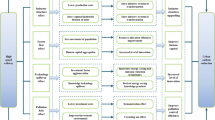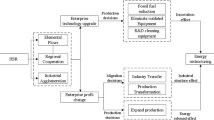Abstract
The construction of high-speed railways and the smart city pilot (HSR-SCP) demonstrates the synergy of traditional and new infrastructure upgrades, which has a significant influence on the economic transition and green economic growth. However, little study has been conducted on the impact of HSR-SCP synergy on carbon emissions. Applying China’s prefecture-level panel data, this paper, therefore, attempts to investigate the effect of HSR-SCP on carbon emissions and uncover its in-depth mechanism through the multi-period difference-in-differences model. Notably, an appropriate instrumental variable for HSR-SCP is introduced to address possible endogeneity. The main conclusions indicate that the construction of HSR-SCP plays an essential role in cutting carbon emissions, which is still valid after adopting the instrumental variable method and some robustness tests. Furthermore, green technology innovation plays a crucial intermediary role in that relationship. Finally, the carbon reduction effect of HSR-SCP is significant in Mid-Eastern China and cities with high population sizes and administrative levels, but not in other cities or regions. The research conclusions demonstrate the significant synergy of traditional and new infrastructure upgrades on carbon reduction and provide an empirical foundation for developing countries to realize low-carbon development through optimizing smart infrastructure and promoting green technology innovation.




Similar content being viewed by others
Data availability
The data used in the study is available from the corresponding author on reasonable request.
References
Baron RM, Kenny DA (1986) The moderator–mediator variable distinction in social psychological research: Conceptual, strategic, and statistical considerations. J Pers Soc Psychol 51:1173–1182. https://doi.org/10.1037/0022-3514.51.6.1173
Beck T, Levine R, Levkov A (2010) Big Bad Banks? The Winners and Losers from Bank Deregulation in the United States. J Financ 65:1637–1667. https://doi.org/10.1111/j.1540-6261.2010.01589.x
Camarero M, Tamarit C (1995) A rationale for macroeconomic policy coordination: Evidence based on the Spanish peseta. Eur J Polit Econ 11:65–82. https://doi.org/10.1016/0176-2680(94)00056-P
Cavada M, Hunt DVL, Rogers CDF (2016) Do smart cities realise their potential for lower carbon dioxide emissions? Proc Inst Civ Eng-Eng Sustain 169:243–252. https://doi.org/10.1680/jensu.15.00032
Chen J, Gao M, Cheng S, Hou W, Song M, Liu X, Liu Y, Shan Y (2020) County-level CO2 emissions and sequestration in China during 1997–2017. Sci Data 7:391. https://doi.org/10.1038/s41597-020-00736-3
Chen Y, Gu X, Gao Y, Lan T (2021a) Sustainability with high-speed rails: The effects of transportation infrastructure development on firms’ CSR performance. J Contemp Account Ec 17:100261. https://doi.org/10.1016/j.jcae.2021.100261
Chen P, Lu Y, Wan Y, Zhang A (2021b) Assessing carbon dioxide emissions of high-speed rail: The case of Beijing-Shanghai corridor. Transp Res Part D: Transp Environ 97:102949. https://doi.org/10.1016/j.trd.2021.102949
Cheng Z, Wang L, Zhang Y (2022) Does smart city policy promote urban green and low-carbon development? J Clean Prod 379:134780. https://doi.org/10.1016/j.jclepro.2022.134780
Chu Z, Cheng M, Yu NN (2021) A smart city is a less polluted city. Technol Forecast Soc 172:121037. https://doi.org/10.1016/j.techfore.2021.121037
Dong X, Zheng S, Kahn ME (2020) The role of transportation speed in facilitating high skilled teamwork across cities. J Urban Econ 115:103212. https://doi.org/10.1016/j.jue.2019.103212
Ferrara R (2015) The Smart City and the Green Economy in Europe: A Critical Approach. Energies 8:4724–4734. https://doi.org/10.3390/en8064724
Gao P, Yue S, Chen H (2021) Carbon emission efficiency of China’s industry sectors: From the perspective of embodied carbon emissions. J Clean Prod 283:124655. https://doi.org/10.1016/j.jclepro.2020.124655
Grossman GM, Krueger AB (1995) Economic Growth and the Environment. Q J Econ 110:353–377. https://doi.org/10.2307/2118443
Gudipudi R, Fluschnik T, Ros AGC, Walther C, Kropp JP (2016) City density and CO2 efficiency. Energ Policy 91:352–361. https://doi.org/10.1016/j.enpol.2016.01.015
Guo Q, Wang Y, Dong X (2022) Effects of smart city construction on energy saving and CO2 emission reduction: Evidence from China. Appl Energ 313:118879. https://doi.org/10.1016/j.apenergy.2022.118879
Guo C, Wang Y, Hu Y, Wu Y, Lai X (2023) Does smart city policy improve corporate green technology innovation? Evidence from Chinese listed companies. J Environ Plann Man 1–30. https://doi.org/10.1080/09640568.2022.2157708
Halkos GE, Paizanos EΑ (2016) The effects of fiscal policy on CO2 emissions: Evidence from the U.S.A. Energ Policy 88:317–328. https://doi.org/10.1016/j.enpol.2015.10.035
Jia R, Shao S, Yang L (2021) High-speed rail and CO2 emissions in urban China: A spatial difference-in-differences approach. Energ Econ 99:105271. https://doi.org/10.1016/j.eneco.2021.105271
Jiao J, Wang J, Zhang F, Jin F, Liu W (2020) Roles of accessibility, connectivity and spatial interdependence in realizing the economic impact of high-speed rail: Evidence from China. Transp Policy 91:1–15. https://doi.org/10.1016/j.tranpol.2020.03.001
Kim K, Jung J-K, Choi J (2016) Impact of the Smart City Industry on the Korean National Economy: Input-Output Analysis. Sustainability 8:649. https://doi.org/10.3390/su8070649
Li L, Taeihagh A (2020) An in-depth analysis of the evolution of the policy mix for the sustainable energy transition in China from 1981 to 2020. Appl Energ 263:114611. https://doi.org/10.1016/j.apenergy.2020.114611
Li Z, Wang J (2022) The Dynamic Impact of Digital Economy on Carbon Emission Reduction: Evidence City-level Empirical Data in China. J Clean Prod 351:131570. https://doi.org/10.1016/j.jclepro.2022.131570
Lin B, Jia H (2022) Does the development of China’s high-speed rail improve the total-factor carbon productivity of cities? Transp Res D Transp Environ 105:103230. https://doi.org/10.1016/j.trd.2022.103230
Lin J, Li H, Huang W, Xu W, Cheng S (2019) A Carbon Footprint of High-Speed Railways in China: A Case Study of the Beijing-Shanghai Line. J Ind Ecol 23:869–878. https://doi.org/10.1111/jiec.12824
Lin X, Zhu X, Feng M, Han Y, Geng Z (2021) Economy and carbon emissions optimization of different countries or areas in the world using an improved Attention mechanism based long short term memory neural network. Sci Total Environ 792:148444. https://doi.org/10.1016/j.scitotenv.2021.148444
Liu Y, Li Q, Zhang Z (2022a) Do Smart Cities Restrict the Carbon Emission Intensity of Enterprises? Evidence from a Quasi-Natural Experiment in China. Energies 15:5527. https://doi.org/10.3390/en15155527
Liu Q, Li H, Shang W, Wang K (2022b) Spatio-temporal distribution of Chinese cities’ air quality and the impact of high-speed rail. Renew Sust Energ Rev 170:112970. https://doi.org/10.1016/j.rser.2022.112970
Liu K, Meng C, Tan J, Zhang G (2023) Do smart cities promote a green economy? Evidence from a quasi-experiment of 253 cities in China. Environ Impact Assess Rev 99:107009. https://doi.org/10.1016/j.eiar.2022.107009
Lu W, Wu H, Yang S, Tu Y (2022) Effect of environmental regulation policy synergy on carbon emissions in China under consideration of the mediating role of industrial structure. J Environ Manag 322:116053. https://doi.org/10.1016/j.jenvman.2022.116053
Strauss J, Li H, Cui J (2021) High-speed Rail’s impact on airline demand and air carbon emissions in China. Transp Policy 109:85–97. https://doi.org/10.1016/j.tranpol.2021.05.019
Su Y, Hu M, Yu X (2023) Does the development of smart cities help protect the environment? J Environ Plan Manag 66:572–589. https://doi.org/10.1080/09640568.2021.1999220
Sun L, Li W (2021) Has the opening of high-speed rail reduced urban carbon emissions? Empirical analysis based on panel data of cities in China. J Clean Prod 321:128958. https://doi.org/10.1016/j.jclepro.2021.128958
Tang Z, Mei Z, Zou J (2021) Does the Opening of High-Speed Railway Lines Reduce the Carbon Intensity of China’s Resource-Based Cities? Energies 14:4648. https://doi.org/10.3390/en14154648
Wang Y, Liao M, Wang Y, Xu L, Malik A (2021) The impact of foreign direct investment on China’s carbon emissions through energy intensity and emissions trading system. Energ Econ 97:105212. https://doi.org/10.1016/j.eneco.2021.105212
Wu S (2022) Smart cities and urban household carbon emissions: A perspective on smart city development policy in China. J Clean Prod 373:133877. https://doi.org/10.1016/j.jclepro.2022.133877
Wu Y, Tam VWY, Shuai C, Shen L, Zhang Y, Liao S (2019) Decoupling China’s economic growth from carbon emissions: Empirical studies from 30 Chinese provinces (2001–2015). Sci Total Environ 656:576–588. https://doi.org/10.1016/j.scitotenv.2018.11.384
Wu C, Ge M, Huang Z, Wang L, Liu T (2023) An extended STIRPAT model and forecast of carbon emission based on green consumption behaviors: evidence from China. Environ Dev Sustain. https://doi.org/10.1007/s10668-023-03077-4
Yan Z, Park SY (2023) Does high-speed rail reduce local CO2 emissions in China? A counterfactual approach. Energ Policy 173:113371. https://doi.org/10.1016/j.enpol.2022.113371
Yigitcanlar T, Kamruzzaman Md (2018) Does smart city policy lead to sustainability of cities? Land Use Policy 73:49–58. https://doi.org/10.1016/j.landusepol.2018.01.034
Yu X, Wan K (2022) High-Speed Rail Opening and Green Innovation—Evidence From China. Front Environ Sci 10:901879. https://doi.org/10.3389/fenvs.2022.901879
Yu F, Lin F, Tang Y, Zhong C (2019) High-speed railway to success? The effects of high-speed rail connection on regional economic development in China. J Reg Sci 59:723–742. https://doi.org/10.1111/jors.12420
Zhang C, Zhou X (2016) Does foreign direct investment lead to lower CO2 emissions? Evidence from a regional analysis in China. Renew Sust Energ Rev 58:943–951. https://doi.org/10.1016/j.rser.2015.12.226
Zhang W, Liu X, Wang D, Zhou J (2022) Digital economy and carbon emission performance: Evidence at China’s city level. Energ Policy 165:112927. https://doi.org/10.1016/j.enpol.2022.112927
Zhao X, Shang Y, Song M (2020a) Industrial structure distortion and urban ecological efficiency from the perspective of green entrepreneurial ecosystems. Socio Econ Plan Sci 72:100757. https://doi.org/10.1016/j.seps.2019.100757
Zhao L, Yang C, Su B, Zeng S (2020b) Research on a single policy or policy mix in carbon emissions reduction. J Clean Prod 267:122030. https://doi.org/10.1016/j.jclepro.2020.122030
Zhao X, Ma X, Chen B, Shang Y, Song M (2022) Challenges toward carbon neutrality in China: Strategies and countermeasures. Resour Conserv Recycl 176:105959. https://doi.org/10.1016/j.resconrec.2021.105959
Zheng J, Assad U, Kamal MA, Wang H (2022) Foreign direct investment and carbon emissions in China: “Pollution Haven” or “Pollution Halo”? Evidence from the NARDL model. J Environ Plann Man 1–26. https://doi.org/10.1080/09640568.2022.2130194
Zhou G, Zhu J, Luo S (2022a) The impact of fintech innovation on green growth in China: Mediating effect of green finance. Ecol Econ 193:107308. https://doi.org/10.1016/j.ecolecon.2021.107308
Zhou Y, Xu X, Tao L (2022b) The impact mechanism of high-speed railway on regional green innovation spillover under multi-dimensional paths. Environ Impact Assess Rev 95:106795. https://doi.org/10.1016/j.eiar.2022.106795
Funding
The authors declare that no funds, grants, or other support were received during the preparation of this manuscript.
Author information
Authors and Affiliations
Contributions
All authors contributed to the study conception and design. Material preparation, data collection and analysis were performed by Liu Gan and Wan Sanyu. The first draft of the manuscript was written by Liu Gan and Wan Sanyu. All authors commented on previous versions of the manuscript and read and approved the final manuscript.
Corresponding author
Ethics declarations
Ethical approval
Not applicable.
Consent to participate
Not applicable.
Consent to publish
Not applicable.
Competing interests
The authors have no relevant financial or non-financial interests to disclose.
Additional information
Responsible Editor: V.V.S.S. Sarma
Publisher's note
Springer Nature remains neutral with regard to jurisdictional claims in published maps and institutional affiliations.
Rights and permissions
Springer Nature or its licensor (e.g. a society or other partner) holds exclusive rights to this article under a publishing agreement with the author(s) or other rightsholder(s); author self-archiving of the accepted manuscript version of this article is solely governed by the terms of such publishing agreement and applicable law.
About this article
Cite this article
Liu, G., Wan, S. Does the synergy of the construction of high-speed railways and smart city pilot cut carbon emissions in Chinese cities?. Environ Sci Pollut Res 30, 93165–93178 (2023). https://doi.org/10.1007/s11356-023-28991-y
Received:
Accepted:
Published:
Issue Date:
DOI: https://doi.org/10.1007/s11356-023-28991-y




